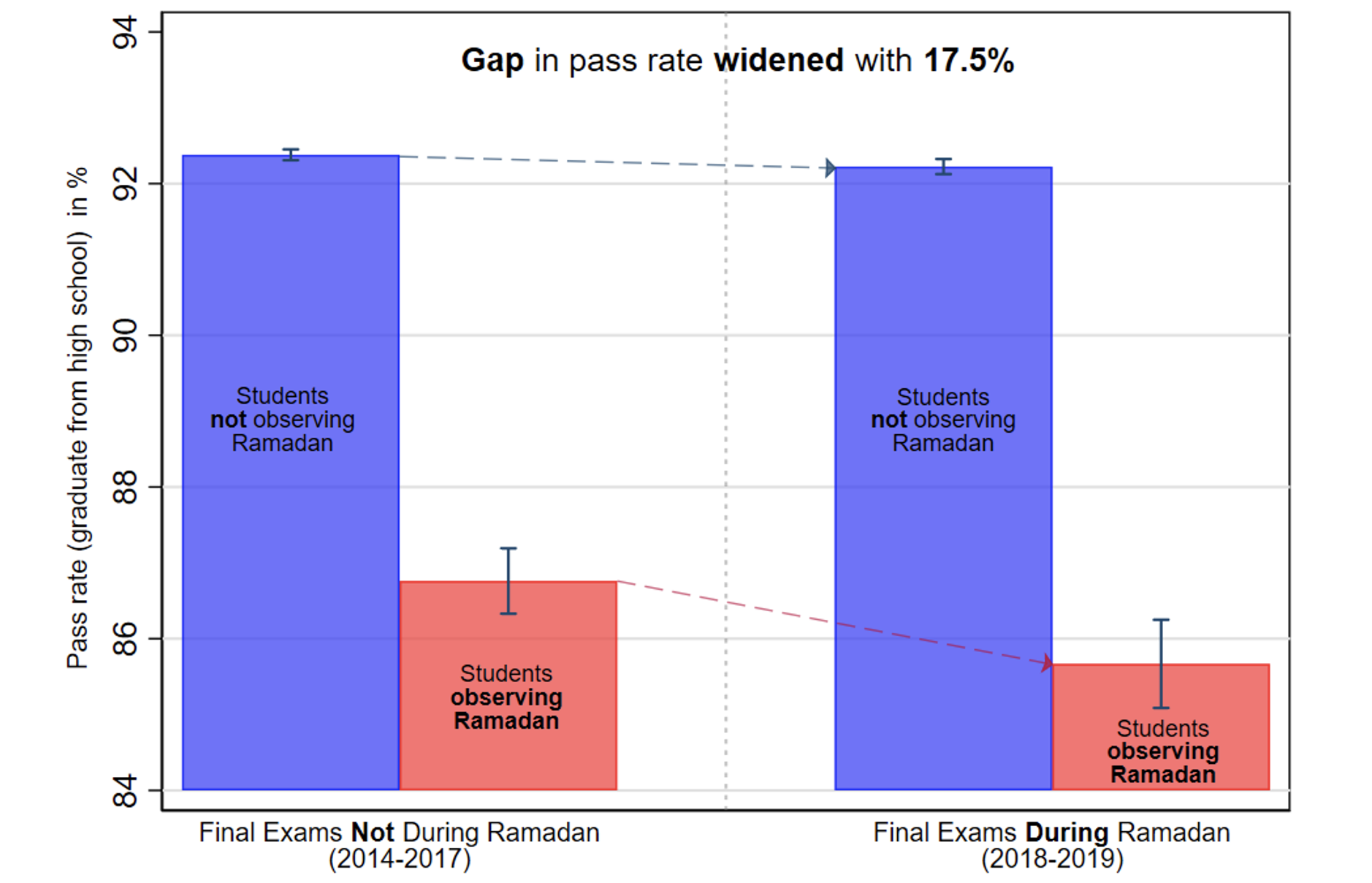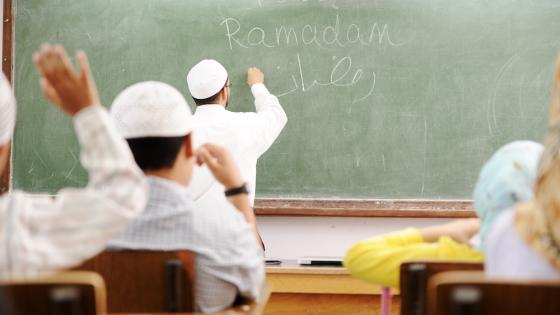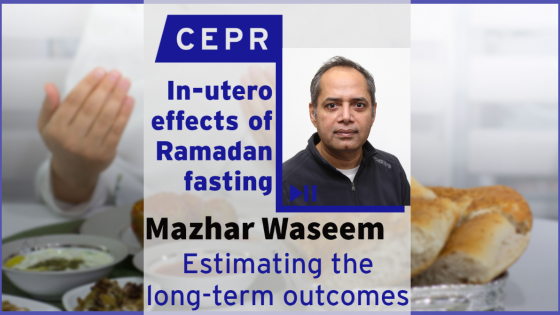The Ramadan period is physiologically demanding for Muslims because they should abstain from eating and drinking between sunrise and sunset throughout that month. During the European summer, meals are consumed very early in the morning (Suhoor) and late at night (Iftar), making the daily fast very long while also causing disruption to the usual sleeping patterns. Both fasting and sleep deprivation have been shown in the medical literature to negatively impact cognitive performance, making it potentially difficult for Muslim students to perform well in exams during Ramadan. Balancing religious commitments with academic endeavours appears challenging, especially in non-Muslim countries that do not accommodate for this. Hence, the overlap between Ramadan and high-stakes exams might represent a relevant obstacle for Muslim minority students’ short- and long-term academic success.
This issue has gained particular attention in recent years as some of the most important tests in a student's academic journey – high school graduation exams and university admission exams – have coincided with Ramadan in several Western countries. This is not always the case since the Islamic calendar is shorter than the Gregorian calendar, and consequently the Muslim holy month moves backwards every year. Between 2018 and 2019 however, Ramadan took place entirely in May and June, the period when the aforementioned high-stakes exams are typically held in most Western countries. Not surprisingly, different media outlets and politicians raised concerns about the potential adverse impact this could impose on an already underprivileged population group. Despite this heightened attention, there was until recently no comprehensive study into the causal effect of Ramadan observance on the performance of Muslim students at high-stakes exams.
The first paper to investigate the impact of Ramadan on student outcome, by Oosterbeek and van der Klaauw (2013), focused on an overlap between the Muslim holy month and classes taken in preparation for a microeconomics exam at a Dutch university. This small-scale study found that every week of Ramadan exposure was associated with a decrease in the exam grade of almost 10% of a standard deviation for the affected students.
More recent studies by Hornung et al. (2023) and Kokkizil (2022) considered the impact of tests taken up to one year after the end of Ramadan, exploiting Ramadan timing and cross-country data at TIMMS and PISA tests. Surprisingly, Hornung et al. (2023) find positive effects of longer fasting hours on students with parents from Muslim majority countries. They argue that this is because Ramadan observance has a positive impact on social capital formation of young Muslim students. On the other hand, Kokkizil (2022) finds that Ramadan makes existing gender norms and stereotypes more salient: in the three months after the end of Ramadan, the academic performance of female Muslim students in STEM subjects significantly worsens compared to their male peers.
In a recent paper (Hanemaaijer et al. 2023), we contribute to this small literature by studying the impact of Ramadan observance on students’ performance when the Muslim holy month overlapped with the high school graduation exams in the Netherlands in 2018 and 2019. We make use of administrative data from Statistics Netherlands which cover the entire population of Dutch high school pupils over multiple years. This enables us to compare outcomes before and during the exam-Ramadan overlap of Muslim and non-Muslim students. The data also contain rich information at the individual, family, neighbourhood, and school level. We match these data with the results of a large Dutch survey on religious practices to develop a machine learning algorithm that assigns a probability of Ramadan observance to each student.
Figure 1 shows the probability assigned by the machine learning model to students with a Moroccan and Turkish migration background. This figure reveals that only using migration background to classify students as compliant to Ramadan obligations, as most studies in the literature do, would lead to a high miss-classification rate for certain minority groups. For example, a large share of students with a Turkish migration background have a compliance probability that is below 50%. To minimise miss-classification, we consider as exposed to Ramadan (treated) only those students with a high compliance probability (above the red vertical threshold shown in Figure 1).
Figure 1 Predicted Ramadan compliance probabilities
Notes: Density distribution of the Ramadan compliance probability as predicted by the machine learning model by migration background (Moroccan background in red and Turkish background in green). The red vertical line defines the threshold for a student being classified as having a high Ramadan compliance probability.
Figure 2 presents our basic identification approach and findings intuitively. It shows the average pass rate at final exams that coincided or not with Ramadan, contrasting the results for treated (Muslim students with a high compliance probability) and non-treated students (non-Muslim students). The already large existing achievement gap between Muslim and non-Muslim students underwent a substantial and statistically significant increase, expanding by nearly 17% during the exam-Ramadan overlap years. These conclusions are substantiated through a difference in differences model that captures the interaction between students' treatment status and the occurrence of Ramadan during exam years, while controlling for an extensive set of individual characteristics, including performance at tests taken prior to the Muslim fast. Our main estimates imply that sitting a high-stakes exam during the Ramadan period results in a decline of 5.8% of a standard deviation for students most likely to observe fasting. This translates into an 8.3% increase in the likelihood of these students failing to graduate. The relevance of these findings is underlined by their implications over the long term: we observe that students aged 18 and above, those allowed to leave school, experience a dramatic 22.5% increase in the probability of dropping out without a diploma when the final exams overlap with the Ramadan period.
Figure 2 Average pass rate at final exams
Notes: The bar graph shows the average pass rate and 95% confidence interval of students with a high Ramadan compliance probability (in red) and students with no Muslim-majority country migration background (in blue). The graph displays the averages for the years in which Ramadan did not overlap with the final exams (2014-2017) on the left, and when it did overlap with the final exams (2018-2019) on the right.
To further explore potential heterogeneities in this average effect, we consider whether the impact of Ramadan exposure is different depending on individual or school characteristics. While we observe no statistically significant gender differences, and students of all ability and income levels experience relatively comparable declines in average grades – with consequently the less able still more affected in terms of pass rate – the impact of Ramadan is not uniform across schools. Students in the most segregated schools, with respect to parental income or to the proportion of students with a high Ramadan compliance probability, are the most affected by Ramadan exposure. Those in schools in the top quartile in terms of compliance probability saw their grades drop by 7% of a standard deviation and were 12.1% more likely not to graduate. In line with these results, we also find suggestive evidence of peer effects of Ramadan observance. We observe that the grades of students who have more complying peers in their school-year-track cohort decline even further.
Finally, we attempt to disentangle the effects of fasting and sleep deprivation, which both occur during Ramadan, on student performance. First, we check if exams taken later into the Ramadan period are relatively more or less negatively affected, assuming that the impact of fasting reduces over time while that of sleep deprivation accumulates (Van Dongen et al. 2003). Here, we find that the drop in performance is the same independent of which week into Ramadan an exam is taken. Our second approach considers how strongly impacted are results at tests that are scheduled in the morning compared to those in the afternoon. Here we find that the time of day when an exam is held represents a relevant factor in determining the Ramadan effect: as shown in Figure 3, sitting an exam during the afternoon reduces the negative effect that we found. However, this is not true when there was already an exam taken by the same student in the morning. We hypothesise this is because those affected by Ramadan can limit its negative effects on performance by taking (long) naps after the early meal when they have no exams in the morning.
Figure 3 Effect on final grade on days with two exams
Notes: The figure displays the point estimates and 95% confidence intervals for the coefficients estimated of the impact of Ramadan exposure depending on the timing of the exam. Afternoon is a dummy that takes value 1 if an exam is held in the afternoon. DiD High Proba is a dummy equal to one if the exam is taken during the Ramadan month by a student with high probability of Ramadan compliance. Two Exams is dummy that takes value 1 if an exam is held on a day in which a student must sit two exams.
This result has clear policy implications: while it may be not viable to avoid any overlap between Ramadan and high stakes exams, it seems feasible to schedule optimally the exams, within the chosen period, to minimise the negative repercussions for Muslim students. Consequently, we put forward a simple recommendation of only scheduling tests in the afternoon with no morning exam before. This adjustment could alleviate the large negative impact we uncover on testing Muslim-minority students when their religious beliefs conflict with their civic duties.
References
Hanemaaijer, K, O Marie, and M Musumeci (2023), "The Fast and the Studious? Ramadan Observance and Student Performance", CEPR Discussion Paper 18203.
Hornung, E, G Schwerdt, and M Strazzeri (2022), “Ramadan intensity and subsequent student achievement”, VoxEU.org, 22 January
Kökkizil, M (2022), “Religiosity and gender gap in STEM performances”, unpublished manuscript.
Oosterbeek, H and B van der Klaauw (2013), “Ramadan, fasting and educational outcomes,” Economics of Education Review 34: 219–226
Van Dongen, H P A, G Maislin, J M Mullington, and D F Dinges (2003), “The cumulative cost of additional wakefulness: dose-response effects on neurobehavioral functions and sleep physiology from chronic sleep restriction and total sleep deprivation,” Sleep 26(2): 117–126.










